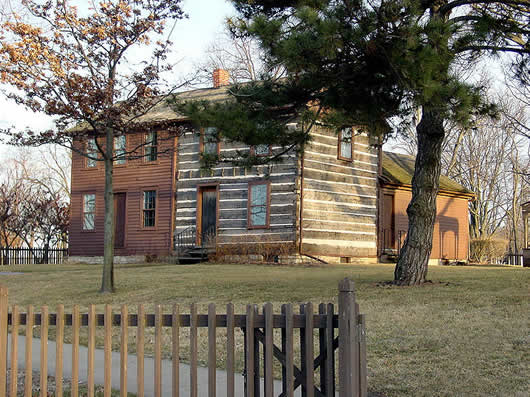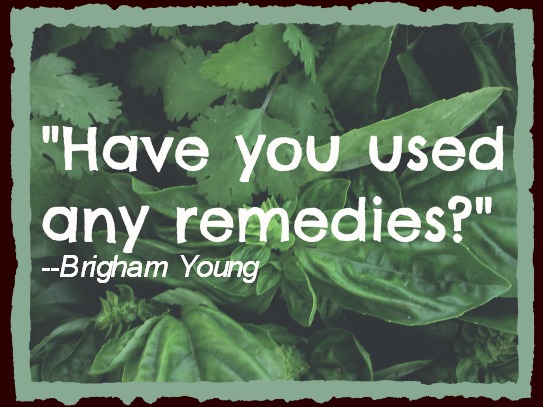Joseph Smith came from a devout Christian family. They did, however, call upon doctors in medical emergencies, even as they turned to prayer in times of dire need. Three emergency events became milestones in the family’s history — a typhus fever epidemic which nearly killed Joseph Smith’s sister and settled in his leg, cured through painful surgery; the death of Joseph’s oldest brother Alvin due to “bad doctoring;” and Joseph’s mother’s close call, wherein her illness was banished because of the power of prayer. Believing both in science and in the gospel of Jesus Christ, Joseph was always on the alert for ways to protect the health of his loved ones and members of the Church.
Folk medicine was popular and oft-relied-upon in the northeastern United States, where the restoration of the Gospel of Jesus Christ took root. When Joseph Smith was translating the Book of Mormon, then, it must have piqued his interest when he came to the following verse:
And there were some who died with fevers, which at some seasons of the year were very frequent in the land – but not so much with fevers, because of the excellent qualities of the many plants and roots which God had prepared to remove the cause of diseases, to which men were subject by the nature of the climate.“ (Alma 46:40)
 Years after its publication in 1822, Joseph Smith became aware of the “New Guide to Health; or Botanic Family Physician,” by Samuel Thompson. Joseph “became a great advocate for the Thompson Botanical Cure, later saying that he was “as much inspired to bring forth his principle of practice according to the dignity and importance of it as I was to introduce the Gospel” (“Journal of Priddy Meeks,” Utah Historical Quarterly 10:199). [1]
Years after its publication in 1822, Joseph Smith became aware of the “New Guide to Health; or Botanic Family Physician,” by Samuel Thompson. Joseph “became a great advocate for the Thompson Botanical Cure, later saying that he was “as much inspired to bring forth his principle of practice according to the dignity and importance of it as I was to introduce the Gospel” (“Journal of Priddy Meeks,” Utah Historical Quarterly 10:199). [1]
The Prophet received by revelation Section 89 of the Doctrine and Covenants, a health law for the “weakest of the weak.” It proscribed the use of alcohol, coffee, tea, and tobacco and recommended good dietary habits. It also mentioned herbs for healing in addition to the healing power of prayer and priesthood blessings:
“And whosoever among you are sick, and have not faith to be healed, but believe, shall be nourished with all tenderness, with herbs and mild food, and that not by the hand of an enemy” (D&C 42:43).
Faith and Science
In 1843 in Nauvoo, Illinois, Joseph was taken ill and was tended to by Dr. Levi Richards, the brother of Willard Richards, Nauvoo’s primary botanical physician and a convert from Massachusetts. [2] “Willard had been trained in the Thomsonian Botanical Method from Samuel Thomson himself. They and their third brother Phineas, another botanical physician, treated their patients with ‘warm medicines’ of which cayenne and lobelia were two principal ingredients…. Willard became the primary botanical physician in Nauvoo, while Levi served as the surgeon general of the Nauvoo Legion, and was the personal physician to the Prophet Joseph and his brother Hyrum.” [2]
Joseph Smith established a board of health in Nauvoo. He wanted only those truly educated in the use of herbs and medicinal treatments of the time to be allowed to use them. Having established the “Relief Society,” the womanhood organization founded by the principles of the Priesthood, Joseph wanted the sisters to be accomplished enough to administer to the sick. Joseph personally set apart in a spiritual ordination, women to serve as midwives and nurses.
Patty Sessions was one of these. She became one of Utah’s foremost early midwives. “Her medical reports were very objective, but her personal journals revealed her deep testimony of the restored gospel, and the inseparable nature of practicing medicine while serving God under the mantle of the Priesthood.” [2]
Although healing by faith and the power of the priesthood was of high importance among the Latter-day Saints, and some people felt that all illness came from the Adversary, Joseph said the following:
“It is not lawful to teach the Church that all disease is of the Devil. But if there is any that has this faith, let him have it to himself. If there are any that believe that roots and herbs administered to the sick and all wholesome vegetables which God has ordained for the use of man, and if any say that such things applied to the sick in order that they may receive health, and this applied by any member of the Church … if there are any among you that teach that these things are of Satan, such teaching is not of God.” (L.D.S. Church Historian’s Office, entry for August 31, 1834). [2]
Miraculous healings were common among the early Latter-day Saints, and they continue to be, but Mormons also believe in science, and as science progresses, it draws closer to the eternal truths already possible to access through spiritual means.
Botanical Medicine Continued Under Prophet Brigham Young
Brigham Young continued to rely on herbs and mild food in times of illness. He sent letters to the Mormon Battalion recommending the same. The U.S. Government had assigned a doctor to the Battalion who hated Mormons, a Doctor Sanderson. Prophet Brigham Young assigned an “Assistant Surgeon” from Mormon ranks, William L. McIntyre, a botanical surgeon, who also valued herbal medicine. The men of the Battalion loved and respected him.
A doctor from Illinois wrote to Brigham Young asking to bring a large group of neighbors to Utah as converts. Prophet Young replied that there was very little need for doctors in Utah. (See “Medicine and the Mormons,” by Robert T. Divett, Bulletin of the Medical Library Association, Vol. 31, No 1, Jan. 1936.)
In Salt Lake City, a “Council of Health” was established, headed by Willard Richards. The council visited Antelope Island in the Great Salt Lake to gather saline plants and roots for herbal medicine. The council was active in discussing medical techniques using herbs in the region.
Said Brigham Young,
“It appears consistent to me to apply every remedy that comes within the range of my knowledge, and to ask my Father in Heaven, in the name of Jesus Christ, to sanctify that application to the healing of my body … it is my duty to do, when I have it in my power. Many people are unwilling to do one thing for themselves in the case of sickness, but ask God to do it all.”
Brigham lived during a time of great forward leaps in medicine, including modern nursing, Pasteur’s discoveries of bacteria, and the use of ether as anesthesia. In 1869 instead of commenting that the Mormons relied too much upon the Lord, he commented that the Saints relied too much upon modern medicine. It must be acknowledged that the Relief Society, the women’s organization of the Church, had been very pro-active in training women as nurses and midwives and in establishing good medical care among the Saints. The practice of plural marriage actually liberated women to go east for medical schooling because they had other women to care for their children at home. Brigham Young called a number of men and women in the Church to go east for medical education.
In 1872, the year he sent a nephew off to medical school, he said,
Would you want doctors? Yes, to set bones. We would want a good surgeon for that, or to cut off a limb. Do you want doctors? For not much of anything else, let me tell you, only the traditions of the people lead them to think so, and here is a GROWING EVIL IN OUR MIDST. … Now the cry is “Send for a doctor.’ If you have a pain in the head, ‘Send for a doctor, if you feel aches, “I want a doctor’ …
Herbalist John Heinerman observed:
“First of all, he believed in doctors, but only to the extent of fractures, sprains and such, with a surgeon necessary for amputation when they may occur … the real reason is because a good majority of the Mormon people wanted these services for themselves in the territory.”
And rather than suffer to see some corrupt Gentile practitioners come in and work their stuff upon the members of the Church, he felt that if they had to have doctors, they might as well have those of their own faith treat them. The territory had already been “blessed” with a few of those kind of the world, and he did not want any more if he could help it. (Joseph Smith and Herbal Medicine, page 93).
However, at his own death on August 29, 1877 he was attended by three prominent medical doctors, his nephew Doctor Seymour B. Young and and Doctors Joseph and Denton Benedict. They were able to administer morphine to ease his terrible pain from inflammation of the bowels and what is believed to be his cause of death, peritonitis from a ruptured appendix. [1]
The first hospital in Salt Lake City was dedicated 25 years after Brigham Young’s death. In 1905 the Deseret News reported the following:
“Remedies are provided by the Great Physician or by Nature as some prefer to view them and we should not close our eyes to their virtues, nor ignore the skill and learning of the trained doctor. It gives evidences that “Mormon” enterprise is abreast of the times and that L.D.S. are ready to avail themselves of scientific knowledge and progress, and are not slow to move with the movement of modern thought and learning.”
Additional Resource:



 Watch a video about the restoration of the gospel on lds.org
Watch a video about the restoration of the gospel on lds.org
is there a good book available about mormon folk medicine?
I’m not aware of one, but it would be interesting! Anyone know?
“New Guide to Health; or Botanic Family Physician,” by Samuel Thompson. -refered to in above article – available on amazon,
just recieved it august 2018
thanks Ralph